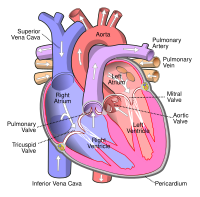
Photo from wikipedia
Isolated tricuspid regurgitation (TR) is an entity of high prevalence and associated with poor prognosis. Traditionally, treatment options have been limited because high surgery mortality. In this context, new percutaneous… Click to show full abstract
Isolated tricuspid regurgitation (TR) is an entity of high prevalence and associated with poor prognosis. Traditionally, treatment options have been limited because high surgery mortality. In this context, new percutaneous therapeutic options have appeared. The objective of this study is to describe the anatomical changes in tricuspid annulus (TA) and the immediate response in the TR severity after implantation of the Cardioband tricuspid system as well as the safety of the procedure. Patients undergoing Cardioband implantation in our center where included. The diameter and area of the TA were measured by 2D and 3D transesophageal echocardiography (TEE) before and immediate after the implantation. TR severity was evaluated by the vena contracta width (VC) in 0 and 90 degrees by 2D TEE. Six patients (81.3 (79–85) years, 66.3% females) were included. The etiology of TR was dilatation of the ring in two cases, secondary to left valvulopathy in three cases and secondary to type III pulmonary hypertension in other case. Four patients presented basal severe TR, and two patients massive TR. A significant reduction in TA diameters (reduction TA diameter 0°: 10.6 mm; 90°: 12.2 mm) and 3D TA area (4.5 mm2) was observed immediately after the procedure as well as a reduction in the VC width (reduction VC 0°: 4.8 mm; 90°: 3.9 mm). Table 1 shows the measurements before and after the procedure. The success of the procedure was 84% (Five patients reduced one-degree TR severity, and one reduced two degrees TR severity). One patient was partial success because the complete implant of all anchors could not be performed. There was 0% intraprocedural mortality or major complications. There were two minor complications, one related to vascular access and the other related to an intra-atrial thrombus, both resolved. The new percutaneous techniques to treat TR are a reality, and preliminary results seem to indicate that they are a safe and effective alternative, reducing the size of the ring and the severity of valvulopathy. Further studies and longer clinical follow-up will lead to the generalization of these new techniques. Type of funding source: None
Journal Title: European Heart Journal
Year Published: 2020
Link to full text (if available)
Share on Social Media: Sign Up to like & get
recommendations!